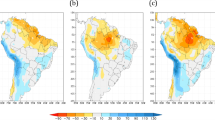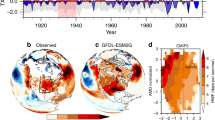Abstract
In a changing climate, changes in rainfall variability and, in particular, extreme rainfall events are likely to be highly significant for environmentally vulnerable regions such as southern Africa. It is generally accepted that sea-surface temperatures play an important role in modulating rainfall variability, thus the majority work to date has focused on these mechanisms. However past research suggests that land surface processes are also critical for rainfall variability. In particular, work has suggested that the atmosphere-land surface feedback has been important for past abrupt climate changes, such as those which occurred over the Sahara during the mid-Holocene or, more recently, the prolonged Sahelian drought. Therefore the primary aim of this work is to undertake idealised experiments using both a regional and global climate model, to test the sensitivity of rainfall variability to land surface changes over a location where such abrupt climate changes are projected to occur in the future, namely southern Africa. In one experiment, the desert conditions currently observed over southwestern Africa were extended to cover the entire subcontinent. This is based on past research which suggests a remobilisation of sand dune activity and spatial extent under various scenarios of future anthropogenic global warming. In the second experiment, savanna conditions were imposed over all of southern Africa, representing an increase in vegetation for most areas except the equatorial regions. The results suggest that a decrease in rainfall occurs in the desert run, up to 27% of total rainfall in the regional model (relative to the control), due to a reduction in available moisture, less evaporation, less vertical uplift and therefore higher near surface pressure. This result is consistent across both the regional and global model experiments. Conversely an increase in rainfall occurs in the savanna run, because of an increase in available moisture giving an increase in latent heat and therefore surface temperature, increasing vertical uplift and lowering near surface pressure. These experiments, however, are only preliminary, and form the first stage of a wider study into how the atmosphere-land surface feedback influences rainfall extremes over southern Africa in the past (when surface i.e. vegetation conditions were very different) and in the future under various scenarios of future climate change. Future work will examine how other climate models simulate the atmosphere-land surface feedback, using more realistic vegetation types based on past and future surface conditions.











Similar content being viewed by others
References
Adosi J, Sivakumar M, Ndiangui N (2007) Seasonal variation of carbon dioxide, rainfall, NDVI and it’s association to land degradation in Tanzania. Climate and Land Degradation 373–389
Alessandri A, Navarra A (2008) On the coupling between vegetation and rainfall inter-annual anomalies: possible contributions to seasonal rainfall predictability over land areas. Geophys Res Lett 35(2)
Allen M, Ingram W (2002) Constraints on future changes in climate and the hydrologic cycle. Nature 419
Brink A, Eva H (2009) Monitoring 25 years of land cover change dynamics in Africa: a sample based remote sensing approach. Appl Geogr 29(4):501–512
Charney J, Stone P, Quirk W (1975) Drought in Sahara—Biophysical feedback mechanism. Science 187(4175):434–435
Chou C, Lo M (2007) Asymmetric responses of tropical precipitation during ENSO. J Clim 20(14):3411–3433
Giannecchini M, Twine W, Vogel C (2007) Land-cover change and human-environment interactions in a rural cultural landscape in South Africa. Geogr J 173:26–42
Goddard L, Graham N (1999) Importance of the Indian Ocean for simulating rainfall anomalies over eastern and southern Africa. J Geophys Res 104(D16):19009–19116
Haylock M, Peterson T, Alves L et al (2006) Trends in total and extreme South American rainfall in 1960–2000 and links with sea surface temperature. J Clim 19(8):1490–1512
IPCC (2007) Climate Change 2007: The Physical Science Basis. Contribution of Working Group I to the Fourth Assessment Report of the Intergovernmental Panel on Climate Change. [Solomon S, Qin D, Manning M, Chen Z, Marquis M, Averyt K, Tignor M, Miller H (eds)] Cambridge University Press, Cambridge, United Kingdom and New York, NY, USA, 996 pp
Jones C (1996) Specification of ancillary fields. Unified Model Documentation Paper No 70. UK Meteorological Office, Bracknell, p 46
Levermann A, Schewe J, Petoukhov V et al (2009) Basic mechanism for abrupt monsoon transitions. Proc Natl Acad Sci U S A 106(49):20572–20577
Liu Z, Wang Y, Gallimore R et al (2007) Simulating the transient evolution and abrupt change of Northern Africa atmosphere-ocean-terrestrial ecosystem in the Holocene. Quat Sci Rev 26(13–14):1818–1837
Narisma G, Foley J, Licker R et al. (2007) Abrupt changes in rainfall during the twentieth century. Geophys Res Lett 34(6)
Patricola C, Cook K (2008) Atmosphere/vegetation feedbacks: a mechanism for abrupt climate change over northern Africa. J Geophys Res Atmos 113(D18)
Reason C, Keibel A (2004) Tropical Cyclone Eline and its unusual penetration and impacts over the southern African mainland. Weather Forecast 19:789–805
Reason C, Rouault M (2006) Sea surface temperature variability in the tropical southeast Atlantic Ocean and West African rainfall. Geophys Res Lett 33(21)
Richard Y, Martiny N, Fauchereau N et al (2008) Interannual memory effects for spring NDVI in semi-arid South Africa. Geophys Res Lett 35:1–6
Rodriguez-Fonseca B, Polo I, Serrano E, Castro M (2006) Evaluation of the North Atlantic SST forcing on the European and northern African winter climate. Int J Climatol 26(2):179–191
Samel A, Wang W, Liang X (1999) The monsoon rainband over China and relationships with the Eurasian circulation. J Clim 12:115–131
Thomas D, Knight M, Wiggs G (2005) Remobilization of southern African desert dune systems by twenty first century global warming. Nature 435:1218–1221
Washington R, Harrison M, Conway D et al. (2006) African Climate Change—Taking the Shorter Route. Bull Am Meteorol Soc 1355–1366
Wessels K, Prince S, Malherbe J et al (2010) Can human-induced land degradation be distinguished from the effects of rainfall variability? A case study in South Africa. J Arid Environ 68(2):271–297
Williams C, Kniveton D, Layberry R (2007) Climatic and oceanic associations with daily rainfall extremes over southern Africa. Int J Climatol 27(1):93–108
Williams C, Kniveton D, Layberry R (2008) Influence of South Atlantic sea surface temperatures on rainfall variability and extremes over southern Africa. J Clim 21(24):6498–6520
Williams C, Kniveton D, Layberry R (2010a) Assessment of a climate model to reproduce rainfall variability and extremes over southern Africa. Theor Appl Climatol 99:9–27
Williams C, Kniveton D, Layberry R (2010b) Idealised SST anomaly regional climate model experiments: a note of caution. Prog Phys Geogr 34(1):59–74
Wilson M, Henderson-Sellers A (1985) A global archive of land cover and soils data for use in general circulation climate models. J Climatol 5:119–143
Wu L, He F, Liu Z (2005) Coupled ocean–atmosphere response to north tropical Atlantic SST: tropical Atlantic dipole and ENSO. Geophys Res Lett 32(21)
Zhong A, Hendon H, Alves O (2005) Indian Ocean variability and its association with ENSO in a global coupled model. J Clim 18(17):3634–3649
Zickfeld K, Knopf B, Petoukhov V, Schellnhuber H (2005) Is the Indian summer monsoon stable against global change? Geophys Res Lett 32
Acknowledgements
This work was supported by a Royal Society Dorothy Hodgkin Fellowship for C. J. R. Williams. The authors wish to thank NCAS-Climate for support during this work, and in particular the NCAS-Computational Modelling Services (CMS) for support with setting up and running the model.
Author information
Authors and Affiliations
Corresponding author
Electronic supplementary material
Below is the link to the electronic supplementary material.
ESM 1
(DOC 32 kb)
Fig. S1
Mean daily 850mb geopotential height differences, DJF 1994–1997, using PRECIS: a) Des-Con. Heights in m. (JPEG 102 kb)
Fig. S1
Mean daily 850mb geopotential height differences, DJF 1994–1997, using PRECIS: b) Sav-Con. Heights in m. (JPEG 88 kb)
Fig. S2
Mean daily 850mb vector wind differences, DJF 1994–1997, using PRECIS: a) Des-Con. Winds in m sec-1. (JPEG 51 kb)
Fig. S2
Mean daily 850mb vector wind differences, DJF 1994–1997, using PRECIS: b) Sav-Con. Winds in m sec-1. (JPEG 49 kb)
Fig. S3
Mean vertically integrated (over all pressure levels) moisture flux differences, DJF 1994–1997, using PRECIS: a) Des-Con. Moisture flux in kg m-1 sec-1. (JPEG 50 kb)
Fig. S3
Mean vertically integrated (over all pressure levels) moisture flux differences, DJF 1994–1997, using PRECIS: b) Sav-Con. Moisture flux in kg m-1 sec-1. (JPEG 45 kb)
Fig. S4
Mean daily surface temperature differences, DJF 1994–1997, using PRECIS: a) Des-Con. Temperature in °C. (JPEG 109 kb)
Fig. S4
Mean daily surface temperature differences, DJF 1994–1997, using PRECIS: b) Sav-Con. Temperature in °C. (JPEG 104 kb)
Fig. S5
Mean daily surface evaporation rate differences, DJF 1994–1997, using PRECIS: a) Des-Con. Evaporation in mm day-1. (JPEG 100 kb)
Fig. S5
Mean daily surface evaporation rate differences, DJF 1994–1997, using PRECIS: b) Sav-Con. Evaporation in mm day-1. (JPEG 100 kb)
Fig. S6
Mean daily omega differences (averaged longitudinally), DJF 1994–1997, using PRECIS: a) Des-Con. Omega in m sec-1. (JPEG 68 kb)
Fig. S6
Mean daily omega differences (averaged longitudinally), DJF 1994–1997, using PRECIS: b) Sav-Con. Omega in m sec-1. (JPEG 61 kb)
Fig. S7
Mean daily 850mb geopotential height differences (Des-Con), DJF 1994–1997, using HadAM3. Heights in m. (JPEG 177 kb)
Fig. S8
Mean daily 850mb vector wind differences (Des-Con), DJF 1994–1997, using HadAM3. Winds in m sec-1. (JPEG 116 kb)
Fig. S9
Mean vertically integrated (over all pressure levels) moisture flux differences (Des-Con), DJF 1994–1997, using HadAM3. Moisture flux in kg m-1 sec-1. (JPEG 101 kb)
Fig. S10
Mean daily surface temperature differences (Des-Con), DJF 1994–1997, using HadAM3. Temperature in °C. (JPEG 173 kb)
Fig. S11
Mean daily surface evaporation rate differences (Des-Con), DJF 1994–1997, using HadAM3. Evaporation in mm day-1. (JPEG 117 kb)
Fig. S12
Mean daily omega differences (averaged longitudinally), Des-Con, DJF 1994–1997, using HadAM3. Omega in m sec-1. (JPEG 88 kb)
Rights and permissions
About this article
Cite this article
Williams, C.J.R., Kniveton, D.R. Atmosphere-land surface interactions and their influence on extreme rainfall and potential abrupt climate change over southern Africa. Climatic Change 112, 981–996 (2012). https://doi.org/10.1007/s10584-011-0266-7
Received:
Accepted:
Published:
Issue Date:
DOI: https://doi.org/10.1007/s10584-011-0266-7




